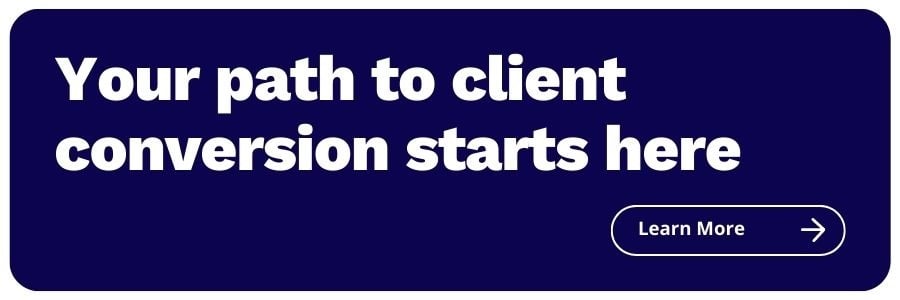Branding Basics: Where To Start as an Independent Financial Advisor
Share this
We live in a world where interacting with brands is part and parcel of daily life. Undoubtedly, you understand the power of branding. Brands have the ability to elicit strong loyalties by tying their service to specific communication choices. Think of Target and Nike as examples. No matter what you think of either of these brands, what comes to your mind is the Target red and the Nike swoosh—the identity of the brands we engage with is inseparable from their branding; this is the communicative power of branding. The work you do and the way you represent it are intimately tied in terms of communicating and creating value around your business. You can take advantage of the power of branding by making more conscious, consistent choices around your design and writing. As a business owner, you’ve put in the effort to formulate what makes your work unique—now, don’t miss the opportunity to successfully communicate that to your prospects and clients.
What is branding?
Branding puts voice to the personality of your business. It’s a reflection of your business identity, a chance for you to communicate what makes your firm unique. As you’re building out a business plan, you’ll think through your mission, core values, niche, and value proposition. Your branding is a hodgepodge of all these considerations cobbled together, communicated in subtle ways (or maybe not so subtle! I don’t know your business) through things like tone and language, design and photography, marketing materials, and much more.
Branding is not a case of set it and forget it. Good brands continually grow and change as businesses adjust for new goals and changing circumstances. The wonderful thing about solid branding is it will provide you with a strong foundation, dynamic enough to move with your firm as you grow. While most businesses rebrand at some point, most bring elements of the original brand with them—think how different Apple’s rainbow logo and iconic 1984 Macintosh ad differs from their branding today. The two versions are completely different takes, but the apple iconography and name have remained. Allow yourself to work from a strong core idea and build on that—know that shifting your approach and how you iterate this idea is inevitable. Even if you rebrand, you will likely retain some elements of your original vision, so make sure something at the core resonates with you. Thoughtfully approaching branding and investing in a few crucial areas early on will serve you for years to come.
Nearly anything—done right—can be a part of your branding. Email signatures? You bet. T-shirts? Absolutely. (Hey, wait, that’s ours!) Handwritten thank-you notes? Definitely. There are countless touchpoints for communicating with clients, and every single one presents an opportunity for you to reinforce your value, tell your story, and share your mission.
Don’t make the mistake of thinking branding is just your logo. A great example is IKEA. What do you think of when you think of IKEA? Probably their logo and colors, and sure, these elements are used in a variety of places, but likely you also think of something more than that. Maybe what comes to mind is the idea of Scandinavian furniture or the act of self-assembly—who can forget the adorable IKEA assembly manual mascot? You might think of those big, friendly messages like “Hej!” used to communicate their personality. Or maybe, like me, you think of those (seemingly indestructible) big, blue bags that IKEA has now made into keychains because they’re so recognizable. Maybe the first thing that comes to mind is the experience—the golf pencils for quick notetaking and signage that help navigate through the mazelike showroom. Maybe you just think of those Swedish meatballs. All of these touchpoints present opportunities for IKEA to reinforce their branding, and they’re so much more than just the logo and colors. Great brands go far beyond the logo, thinking about color and pattern, but also experience and language to make their work meaningful and memorable.
Building your brand is an iterative, creative process. It doesn’t all pop up at once but slowly emerges through a process of continual reformation. Allow yourself to get in creative mode when you’re thinking through your branding. This is the perfect time to ask yourself, “What if?” and build on the wild ideas that come. Branding is about selling value, sure, but it’s also about building trust. Let your brand speak in a way that feels comfortable and authentic—inject some humor or create moments of surprise.
Typically, branding begins with color and typography from which to build out the rest of the system. That said, there’s absolutely no rule saying you need your colors figured out first. Don’t feel boxed in by the need to start with any one brand element. You can start wherever sparks joy and build from there. Allow the ideas to lead the way and inform the direction your brand goes. Your branding should encompass more than just visual cues—starting with an idea can be a great approach to building a unique brand. Your brand will always encompass more than can be explicitly written down in words.
Brand, branding, and brand identity systems
We often use the words “brand” and “branding” synonymously. Let’s take a moment to consider the difference.
A brand is the outside perception of your business. This is the identity others associate with you—subjective and slippery, built on any number of factors both in and out of your control.
Branding is the active shaping of this perception from a strategic perspective. Branding is the conscious work that goes into shaping your brand, from the way you tell your story on your website to the structure of client engagements you offer.
A brand identity or identity system comprises all the tangible elements that work together to enforce your brand. This is the nitty-gritty of specific words, patterns, styles that work together in any number of collateral pieces.
What makes up branding?
Well, how long have you got? Branding can encompass everything from the color of the walls in your office to the navigation structure on your website. Everything visible from an external party speaks to your brand, which is why it’s so crucial it speaks to your mission. Trying to align yourself to a brand that doesn’t fit is just about as easy as walking around in shoes two sizes too big—doable, but not ideal.
For the sake of discussion, we’ll parse out a brand into four major categories:
- Creative origins: This is the idea piece; it’s the foundational thought that guides your personality as a business, driving your tone, informed by your niche. This is likely the area you’ve given the most thought to already. The bulk of this can be drawn from your mission, vision, and value proposition, but let yourself be inspired by these elements and explore ideas that will resonate with your niche.
- The Big Three: Logo, color, and typography. These are your foundational graphic elements that serve as the baseline for your branding. All your visuals should stem from this core. This element may also include textures, patterns, or shapes, likely inspired or heavily influenced by the aforementioned Big Three.
- Voice, tone, and writing: What you say is as important as how you present it. As a designer, I tend to focus on the how of communicating but spend some time considering what kind of language and tone feels appropriate and comfortable to you. Speak to your niche, yes, but know your business is a part of you, and your unique voice is important as well.
- Collateral: This is where your brand comes to life and is the space where the previous three come together. From huge projects to tiny elements, from your website to your email signature, this can be anywhere you incorporate both visuals and writing to communicate about your business.
To reiterate, all of these are dynamic, flexible pieces. While consistency is essential to maintain a brand, slight shifts here and there will help evolve your brand as you grow, allowing you to stay relevant to your clients and remain true to your changing business. Each of them is important to building a strong, sustainable brand. Each also requires different skillsets and particular mental spaces to explore.
How do I build a brand?
Look, I hate to be the one to tell you this, but there’s absolutely no single correct answer here. There are probably as many ways to build a brand as there are brands in existence. Depending on your comfort level and availability, you may choose to DIY design your entire brand or hire out a full agency for the complete brand package. Either one can work but be brutally honest with your own capabilities—there’s a lot you can do yourself, but it may be well worth the money to get the basic visual elements sorted by a designer.
If you hire an agency, they should walk you through the entire process from start to finish, from basic ideation around your business (even naming!) to the nitty-gritty of what your business cards will look like. This is likely the most expensive route, but judging by their portfolio of work and your initial discussions with the team, it should give you the most confidence in getting a quality product.
You may opt to hire a la carte design help, maybe someone to put together the fundamentals and someone to take on the website while DIYing the rest of the materials. I’d recommend this route for most businesses just getting off the ground, though it will require you to do some of the initial deep thinking work as well as sourcing quality templates to build additional materials around. If you’re looking for a designer for a one-off project, I’d recommend looking through Upwork or Dribble, which both allow you to search by specialty and see a portfolio of work, which will give you an idea of their style and pricing. I caution heavily against sites that feature a bidding style process—I understand it is tempting to simply write a prompt and see what kind of logo you can get for $10, but know you will absolutely get what you pay for and depending on how your business takes off, you may be stuck with it long-term. Working with a designer you know and trust with a set agreement, a conversation around your goals, and upfront payment for services will pay dividends in the end. (Hey, wait a minute, I know another industry that benefits from a fee-for-service model!) I highly recommend doing your best to find a local designer to work through some of these pieces with you, if at all possible.
Many new firm owners go the entirely DIY route, and there’s absolutely nothing wrong with bootstrapping your brand at the start. There are a lot of tools and templates out there that can help you get the ball rolling in terms of your brand basics. The most important piece here is to work on consistency, especially in your colors and fonts. In all likelihood, you will learn so much in your first year about the kind of business you want to run that you’ll revisit many of your materials in year two or three. (Most businesses undergo some sort of rebrand during their lifetime—ideally no more than once a decade or so, though.) That said, I highly recommend hiring a designer for at least your foundational pieces. As the core of your brand, everything visual should tie into these, so it’s imperative they speak to your central vision at some level. Even if you plan to rebrand when your firm has matured a bit, you’ll likely want to retain some elements of your brand (like the name and color family at least, although likely more). For this reason, you want to ensure that at least a few elements of your visual materials resonate with you. Branding is, after all, what greets your prospects at the door—you want them to know they are in the right place and can come right on in.
Share this
- Running Your RIA Efficiently: Outsourcing Bookkeeping with XYPN Books
- Road to Launch with XYPN Member Alan Skillern, CFP®, MBA
- Coaching for Better Time Management: Prioritizing Organic Growth in Your Daily Routine
- Boost Your Financial Advisory Practice: SEO Strategies and CRM Optimization for Sales Success
- Advisor Blog (693)
- Financial Advisors (221)
- Growing an RIA (99)
- Digital Marketing (87)
- Marketing (84)
- Community (81)
- Start an RIA (76)
- Business Development (72)
- Coaching (72)
- Running an RIA (70)
- Compliance (69)
- Client Acquisition (65)
- Technology (64)
- XYPN LIVE (59)
- Entrepreneurship (57)
- Sales (49)
- Practice Management (44)
- Client Engagement (41)
- Bookkeeping (38)
- XYPN Books (38)
- Investment Management (37)
- Fee-only advisor (36)
- Lifestyle, Family, & Personal Finance (31)
- Employee Engagement (30)
- Client Services (25)
- Financial Education & Resources (25)
- Journey Makers (21)
- Market Trends (21)
- Process (14)
- Niche (11)
- SEO (9)
- Scaling an RIA (9)
- Career Change (8)
- Transitioning Your Business (7)
- Partnership (6)
- Transitioning To Fee-Only (4)
- Social Media (3)
- Transitioning Clients (3)
- Emerald (2)
- Persona (2)
- RIA (2)
- Onboarding (1)
- Sapphire (1)
Subscribe by email
You May Also Like
These Related Stories

Laying the Foundation for Your Brand
Mar 10, 2025
4 min read

15 Free Branding Resources for Financial Advisors
Aug 27, 2018
7 min read





